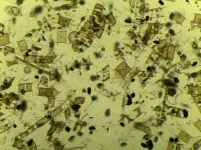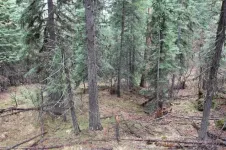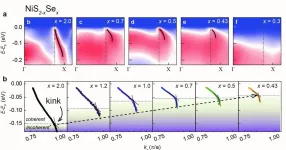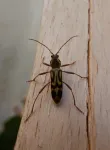(Press-News.org) In light of the United Nations (UN) declaration that 2021-2030 is the UN Decade on Ecosystem Restoration, a group of scientists voice concerns about restoration in heavily fragmented landscapes under a hotter and drier future scenario.
Poor recovery of small fragments will end up costing management and wider society later down the line. Millions are invested in setting aside patches, but management is then weak and costly.
Rainforests turn into oil palm plantations
The past 40 years in Southeast Asia have seen about 50% of lowland rainforests converted to oil palm and other plantations, and much of the remaining forest heavily logged.
Little is known about how fragmentation influences recovery and whether climate change will hamper restoration.
"Here, we use repeat airborne LiDAR surveys spanning the hot and dry 2015-16 El Niño Southern Oscillation (ENSO) event to measure canopy height growth across 3,300 ha of regenerating tropical forests spanning a logging intensity gradient in Malaysian Borneo", says postdoctoral researcher Matheus Nunes from the University of Helsinki, lead author of the paper recently published in Nature Communications.
Repeat high-density airborne LiDAR across the human-modified forests of Borneo provided a unique perspective on the regrowth of forests during the 2015-2016 ENSO and the environmental controls on the canopy. Regeneration of logged forests was still positive during the hot and dry ENSO in Borneo when the highest temperatures and the highest VPD exceeded 2.1 °C and 140% the local long-term average during non-El Niño years. The results demonstrate that regenerating logged forests in this landscape - which contain a high abundance of pioneer tree species with acquisitive traits - continued to grow, despite the high temperatures and water demand in these logged forests.
However, the predictions revealed in the paper show that environmental controls were key to modulating regrowth at the landscape level.
Fragmentation effects increased exponentially with proximity to oil palm plantations, which is consistent with the long-term fragmentation effects that lead to tree mortality and lower productivity.
"Additionally, we demonstrate that the position of fragmented forests across the landscape was also a predictor of forest growth, with valleys and riparian forests showing higher canopy growth compared to those on hilltops during the El Niño", says Nunes.
Suggestions to the Roundtable for Sustainable Oil Palm
Oil palm companies that have joined the Roundtable for Sustainable Oil Palm are committed to the protection of high conservation value forests along rivers and on steep slopes within their estates.
"Our results suggest buffers have to be wide (at least 40 m on each side of the river) to ensure the interior of the strip retains a stable canopy height during droughts", says Nunes.
This is twice the width of what is currently required by law in Sabah, Malaysia. If designed and protected appropriately, riparian reserves in oil palm estates support regrowth with potential positive consequences for the global carbon cycle and for ecosystem function.
The results also demonstrate that small, fragmented patches of regenerating logged forests left on hilltops will be slow to recover due to lower water availability, particularly as El Niño events are becoming more frequent as a result of climate change. Fragmentation in these regenerating logged forests leads to consistent canopy loss within 110 m from oil palm plantations. These results suggest that small patches of logged forests on hilltops will not recover, reflecting the intertwined effects of fragmentation and climate.
INFORMATION:
Reference:
Recovery of logged forest fragments in a human-modified tropical landscape during the 2015-16 El
Niño: Matheus Henrique Nunes, Tommaso Jucker, Terhi Riutta, Martin Svátek, Jakub Kvasnica, Martin Rejžek, Radim Matula, Noreen Majalap, Robert M. Ewers, Tom Swinfield, Rubén Valbuena, Nicholas R. Vaughn, Gregory P. Asner and David A. Coomes Link to Nature Communications https://www.nature.com/articles/s41467-020-20811-y
https://doi.org/10.1038/s41467-020-20811-y
More details:
Mathes Nunes, matheus.nunes@helsinki.fi, + 358 50 4755399
Scientists have pinpointed the location of an essential enzyme in plant cells involved in photosynthesis, according to a study published today in eLife.
The findings overturn conventional thinking about where the enzyme resides in plant cells and suggest a probable role in regulating energy processes as plants adapt from dark to light conditions.
During photosynthesis, plants convert carbon into energy stores through 'electron transport', involving an enzyme called ferredoxin:NADP(H) oxidoreductase, or FNR.
Plants can switch rapidly between two types of electron transport - linear electron flow (LEF) and cyclic electron ...
Gas and liquid separation processes in the chemical industry could be made more efficient and environmentally friendly by using substances known as intrinsically porous materials (IPMs). KAUST researchers review the prospects for IPMs in the journal Accounts of Chemical Research.
Niveen Khashab and her team are currently heavily involved in IPM research. "We focus on making materials that will have an impact on the chemical and petrochemical industries in Saudi Arabia and the world," says Niveen Khashab, the corresponding author of the review.
IPM materials can separate gases and liquids without using traditional ...
The annually occurring algal spring blooms play an important role for our climate, as they remove large amounts of carbon dioxide from the atmosphere. However, they are an ephemeral phenomenon. Most of the carbon is released into the water once the algae die. There, bacteria are already waiting to finish them off and consume the algal remains.
Previous studies have shown that in these blooms, different algae can come out on top each year. However, within the bacteria subsequently degrading the algae, the same specialised groups prevail year after year. Apparently not the algae themselves but rather their components ...
According to an international study published in Frontiers in Psychology, people around the world have reported changes in their physical activity levels, wellbeing, and eating habits during the first stages of the COVID-19 pandemic. A decrease in physical activity during the pandemic was associated with poorer perceived physical and mental health. Reduced exercise was also associated with perceptions of weight gain and decreased sleep.
More than a thousand individuals from several countries with different containment measures participated in an online survey that explored changes in physical activity, eating, sleep, physical and mental health, and wellbeing during the first lockdown phases ...
A RAND Corporation report funded by The Rockefeller Foundation shows that COVID-19 testing can be effectively integrated into K-12 schools' pandemic response plans, helping families and staff feel more comfortable with in-person instruction.
The report found that even for well-resourced districts and schools, launching a COVID-19 testing program was a major undertaking that required access to rapid-turnaround tests, additional staffing or strong partners for logistical support, technical assistance for the design and execution of testing programs, and a strategy for successfully engaging the school community to participate ...
Adding a simple polymer to fertilizers or pesticides could dramatically reduce agricultural pollution, suggests a new study by researchers at the University of British Columbia.
When agrochemicals are sprayed onto crops, a large amount typically ends up in the surrounding environment due to droplets splashing, rebounding or rolling off the target plants.
This amount could be cut at least in half by mixing fertilizers and pesticides with a small quantity of polyethylene oxide, a common polymer additive that improves the ability of agrochemical solutions to stick to plant surfaces, ...
CORVALLIS, Ore. - A quarter-century-old harvesting restriction intended to last one year has served as an obstacle to returning eastern Oregon national forests to the healthier, more fire-resilient conditions they embodied in the late 1800s, research by the Oregon State University College of Forestry shows.
The findings, published in Ecosphere, are both important and timely because the U.S. Forest Service recently revised what has widely become known as the "21-inch rule" - a prohibition against cutting trees greater than 21 inches in diameter at breast height on Forest Service land in eastern Oregon.
"Under the old policy, live trees more than 21 inches in diameter ...
Strongly correlated systems are materials that exhibit strong interactions between electrons, a property unseen in ordinary conductors or insulators. Typical examples include metal-insulator transitions or unconventional high-temperature superconductivity where the resistance becomes zero at high temperatures.
There have been studies to explain this strong interaction between electrons and their characteristic energy scales, but no direct observation on such energy scales through theory or experiments has been reported. To this, the POSTECH-IBS joint research team has succeeded in directly observing the evolution of coherence energy ...
WASHINGTON--Illegal use of anabolic steroids not only has dangerous side effects during use but also can harm of men's testicular function years after they stop abusing steroids, according to a study published in the Endocrine Society's Journal of Clinical Endocrinology & Metabolism.
Anabolic steroids are synthetic forms of testosterone, and their abuse is prevalent among athletes worldwide. Some people use these steroids without a prescription to improve athletic performance or get a more muscular look. Known side effects of these drugs in men include breast growth, hair loss, shrunken testicles and lower testosterone levels. Also called hypogonadism, low testosterone can cause decreased sex drive, poor erections and a low sperm count.
"It is still debated whether illicit ...
A worryingly high number of Asian bamboo longhorn beetles (Chlorophorus annularis) turn out to have been emerging across Europe for about a century already, finds an international research team, headed by researchers from the Center of Natural History, University of Hamburg, Germany. Curiously, the recent records of the invasive, non-native to the Old Continent species are mostly sourced from citizen scientists and online platforms, which proves the power of involving the public in species monitoring. The study is published in the open-access, peer-reviewed ...





